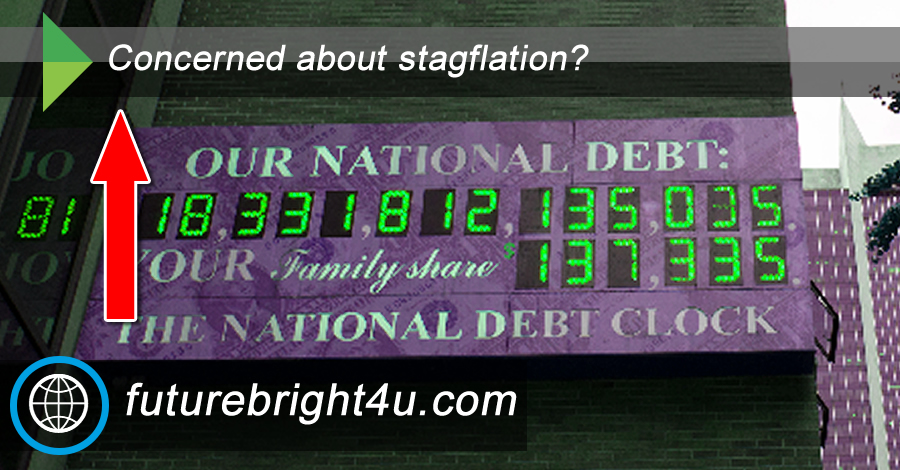2024 Q1 Market Commentary…
For some portfolio managers and investors, the desire for Fed interest rate cuts is akin to that of a sugar addict’s desire for his or her next candy fix. Both are signs that there are greater problems afoot. I’ll stick with the interest rate discussion since I’ve been known to enjoy one too many desserts, and I don’t qualify as a pillar of optimal health.
An interest rate cut is done for one of two reasons (or both): 1) to stimulate a weak economy; or 2) to dig an economy out of recession. Money is less expensive to borrow when rates go lower, which allows consumers to consider more and bigger purchases. In terms of credit, lower rates increase purchasing power, which can have a ripple effect as it stirs up more economic activity. Nevertheless, a rate cut is still an admission that the economy is not in good health. The reality is just because we have more credit capacity to work with doesn’t mean we should use it. See www.usdebtclock.org for reference.
If rate cuts are an admission that the economy is unhealthy, why do investors like rate cuts so much? It’s quite simple. Typically, people who have money to invest don’t carry a lot of debt. Maybe they have a mortgage or car payment, but not usually more than that. More purchasing power among those who live debt-free equates to more investment power. They don’t care about more credit capacity. It’s the derivation of the adage, “the rich get richer, and the poor get poorer.” But wait, there’s more…
We must acknowledge the interest rate’s archenemy – inflation. If the economy sees sustained higher prices on goods and services EVEN WHEN THE ECONOMY IS WEAKENING, it’s nearly impossible to cut rates. You get the phenomenon known as stagflation. Well, it’s hardly a phenomenon anymore. It’s almost one of life’s guarantees since the early 1970’s. We are so close to it once again.
Old school economists never thought stagflation to be possible, but we have over 50 years of proof that it can happen and does. The last time we saw prices decline year over year was during the financial crisis of 2008, and even that was limited to just lower energy and transportation prices. Which brings up a good point, by the way…when you hear on the news that inflation is going down, it’s the greatest misnomer in the financial news reporting pantheon. It’s only disinflation, which is just a slowing of the pace of inflation, not a reversal of prices downward. Inflation and deflation are the only two measures of directional changes in prices, and we have not seen deflation in a long, long time.
Investors hate stagflation. Why? Because talks of rate cuts go out the window. Yet, if you wait to cut too late in an economic downturn, it can stifle economic growth and add to more job losses and severely worsen a recession. Orchestrating a “soft landing” (i.e. – cutting interest rates at the optimal time and frequency as to not hurt the economy) becomes more like threading a needle with shaky hands. No Fed official has ever perfected it. Just sayin…
So, how do we conquer stagflation and reignite economic prosperity and growth? It’s hard to do because the two components of stagflation – recession and inflation – are diametrically opposed to each other. To stimulate the economy, we cut rates. To slow the flow of money to cool inflation, we raise rates. So, are we left to just allow the Fed to choose which side they favor in the battle? But wait, there’s more…
What fiscal restraint has Congress shown over the last 50 years to help the Fed out? Virtually, none! Unconstrained government spending only stokes stagflation risk, and we have numerous decades of printing money done by both parties that has exacerbated our situation. See www.usdebtclock.org again for reference.
What’s the solution for stagflation? Price controls? Wage freezes? Not a chance. Politicians would never surrender their own careers for such measures. (Cough, “term limits!”, cough)
The 1970’s stagflation ended with a global recession and a surge in economic debt among emerging markets and developing economies, particularly those with lower incomes. In other words, it wasn’t ideal. By 1979, inflation was at 13.3%, and by 1982, unemployment was at 10.8%. Those were large pills for America to swallow. Fed Chair Volcker eventually raised rates to fight inflation, as President Carter relented on his ambitious government spending program. That served as a tourniquet.
The one factor that does not get the credit it deserves for helping the country climb out of stagflation was deregulation. In the late 70’s, the Carter administration made the decision to deregulate certain industries, including air and ground transportation and the savings and loan industries. There were casualties from that change in policy and it came with some uncomfortable price hikes, but it did increase competition and stimulate new investment. It also forced inefficient firms to either find more operational efficiencies or get left in the dust.
I’m all for responsible government oversight. I really believe the US Government has a duty to protect the public’s best interests and every individual’s financial security. However, I also like rockets shooting into space and landing where they started, and robots delivering food, and phones that can signal the authorities that I’ve been in a car accident, and sushi served to my restaurant table via a conveyor belt, and machines that can detect guns carried into NFL football stadiums, and LIDAR technology, and better golf balls, and helmets that reduce concussions, and thousands of artificial intelligence apps that I thought I’d never see in my lifetime. These advances in innovation aren’t conceived under the threat of Government over-regulation. They thrive under a government that keeps a watchful eye, but not a scornful one.
I’m not trying to say I have all the right answers to solve stagflation when it arrives, but history has showed us how it was once mitigated. It’s on us, as Americans, to get it fixed.







